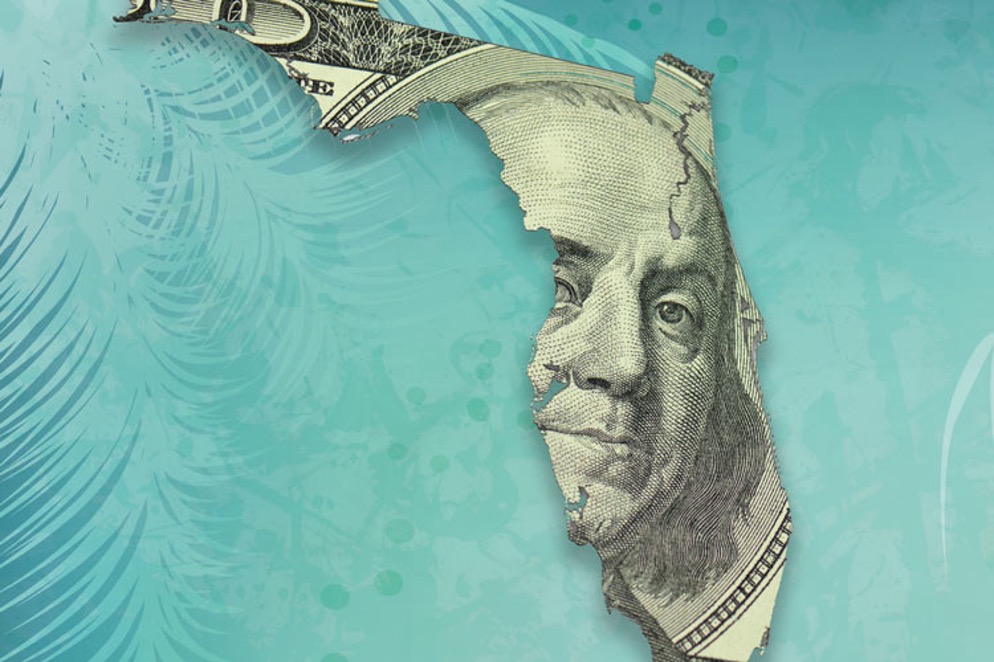
FLORIDA INVESTS IN THE FUTURE WITH BUDGET BOOSTING EDUCATION, ENVIRONMENT, AND PUBLIC SAFETY
Each year, the 160 men and women elected by Floridians to the state’s House (120 members) and Senate (40 members), along with the governor, pass a state budget.
While spending billions of dollars on behalf of everybody else might sound fun, appearances can be deceptive.
“From a policy perspective, the differences between the governor and the leadership over significant issues meant they had to spend a second session of the Legislature to enact a budget—and that is their only constitutional responsibility,” said Peter Bergerson, professor emeritus of political science and government at Florida Gulf Coast University. “A state’s budget is the most important document in state government, because this is always an indication of priority values, regardless of political posturing or campaign promises. The real deals are represented in appropriation—this is where the values are.” In passing the budget, “their job is to educate, medicate, and adjudicate. Particularly from an educational standpoint, this session was a disappointment for sure.”
Bergerson noted that current federal values in education were reflected in policy decisions about it, from public schools to public universities.
Nevertheless, new appropriations provide money to several state universities and have established spending of more than $9,000 per student in Florida public schools. That’s a first in the state, although a level long since passed by some other states. Teachers got a raise, like police, whose starting salary must now be $60,000 per year.
But that was a small part of what happened between March and June 30, when the governor signed off. This budget making period evolved from a history of steadily increasing populations and steadily, even dramatically, increasing budgets.
In 2005, when 17.8 million people called the Sunshine State home under Gov. Jeb Bush, the budget was $55.4 billion, money designed to keep Florida aloft in public safety, education, infrastructure, environment, and health care.
Ten years later, in 2015, with 20.2 million residents and Sen. Rick Scott then serving as governor, he signed off on a budget of $78.7 billion while cutting the state’s regulatory arm of environmental stewards roughly in half.
And this year, finally, with 23 million people living in a state where Gov. Ron DeSantis began his penultimate year at the helm of state government, the budget hammered out now tops off at $117.4 billion—a lot more than a decade ago, but a little less than the Legislature anticipated with its $117.9 billion plan, and less than last year’s budget. The governor vetoed $567 million in proposed spending.
To put all that money in perspective, according to one estimate, $1 billion alone could buy 1,900 middle-range homes, a private island like Pumpkin Key, or a fleet of expensive jets, including as many as 20 Boeing 737s or Airbus A320s.
And that’s only $1 billion. With $117.4 billion, you could restore the Everglades completely five times over at the estimated price of $23 billion by mid-century, when all 60 or so projects in the Comprehensive Everglades Restoration Plan or CERP may finally be complete.
None of it’s nearly as much as Elon Musk is said to be worth, at roughly $400 billion, but it’s enough to do a few things in the state: provide a couple of billion in tax relief for some people; offer pay raises to teachers, cops, and judges while increasing the number of circuit court judges; pay off $830 million in state debt while giving state employees a 2% raise; maintain billions in a state reserve fund; and toss a little money this year to the arts, which have demonstrated a return of between $6 and $9 for every dollar spent.
Last year, the governor vetoed all culture and arts funding in Florida, about $32 million proposed in that budget. This year, he let about $18.3 million pass to 184 organizations that met the new required rankings in the culture and museum grants category, and some much smaller sums for other arts categories.
“It’s just a fraction of the state budget, like one one-hundredth of a percent, so small as to be negligible,” said Tom Hall, a longtime arts advocate and commentator for public media’s WGCU on the southwest coast. “When you look at that compared to the money arts organizations contribute to the state economy, it really is short-sighted. They’re basically paying lip service to the arts.”
Of over 900 Florida arts organizations that sought state aid and qualified by previous standards, fewer than 250 received it, arts proponents say. Still, that’s better than last year.
There’s some money for homeless populations and veterans in the mix as well.
“We were very scared about what the state and federal budgets were going to mean for our clients,” said Angela Hogan, director of Gulf Coast Partnership in Charlotte County, which works with the community’s most vulnerable populations, including homeless veterans. “Ultimately, for the next year, we’re okay,” she said. “After that, we may see some dramatic change, the same we’ve seen on the federal level. But the state was good and fair to folks experiencing homelessness.”
For veterans plagued increasingly in recent years by suicide, the Legislature and governor agreed to spend $300,000 to expand the suicide prevention program in Florida, home to currently more than 1.4 million veterans. It will also fund suicide prevention training for VA officers.
The 2025/26 budget also addresses the environment, which all Floridians rely on personally and economically. It stands out as one of the most significant and singularly bipartisan issues.
Despite other budget cutbacks, many environmentalists were pleased with funding allocated to numerous projects. “Since taking office, Gov. DeSantis has signed seven state budgets that consistently prioritize environmental protection, demonstrating his administration’s long-term commitment to safeguarding Florida’s natural resources,” said Alexis Lambert, secretary of the state DEP, in a statement. “Those investments reflect a smart balance between conservation and growth, recognizing that protecting our environment is not just good policy—it is essential to keeping Florida a place where families, businesses, and communities can thrive.”
The DEP characterized a budget that “emphasizes the Everglades and improvements in water quality, while hardening Florida’s coastlines and strengthening the state’s infrastructure to withstand natural disasters.”
Allocations include $1.4 billion for targeted water quality improvements and restoration. The budget earmarks $200 million for resilience along the coasts and inland, $50 million for finding alternative water supplies, and $50 million more for beach renourishment.
Those commitments in money win the praise of a broad range of environmentalists.
“The high-profile projects, such as elements of the Comprehensive Everglades Restoration plan—that’s great,” said James Douglass, professor of marine and earth science at Florida Gulf Coast University. “But there’s an across-the-board need for state support for local governments trying to implement piecemeal environmental fixes such as septic upgrades, and they’re stymied for lack of funds they hoped to get from the state. It’s just not possible for some of these small, underfunded municipalities to implement these small but sometimes very necessary fixes to address the pressures of a growing population.”
Douglass continued, “We have these 1960s-level wastewater treatment plants not keeping up with the modern era, and they’re decaying. High fecal bacteria levels and nutrient levels in waters are coming from leaky pipes and lots of little spills—that takes money to fix, and we’re not getting it from the state level.”
Annual state budgets are big, complicated affairs that may ultimately nod to the needs of many while fully pleasing few.
Palm Beach County Commissioner Gregg Weiss, who hails from District 2 in West Palm Beach, has a somewhat promising view of the big picture. “We are in better shape than we have been in the past—there were fewer vetoes than we received in past sessions. What’s important to me is water and the C-51 reservoir—and there’s $65 million in the budget for that.”
The C-51 will help store stormwater to be released in the dry season and may help restore the Lake Worth Lagoon and the Loxahatchee River. It could ultimately include 60,000 acre-feet. “The Lake Worth Lagoon Initiative will receive $897,000 this year, which is money for restoration and studying or testing the water,” Weiss said. “And the Loxahatchee River Preservation Initiative got $486,000—adjacent to that is the restoration of the Kennedy Bunker historic site, which received $500,000.”
The Kennedy Bunker is on Peanut Island and dates from the days when President John F. Kennedy spent time in the area early in the 1960s and might have needed a secure facility and protection from an atomic or nuclear attack.
“Another thing on my radar is smart signalization,” he said. “Last year, they budgeted $1.5 million, and this year, they expanded the project with another $3 million for north-south traffic signals from I-95 to Flagler. It’s safer and more efficient. Computers observe what’s happening in real time on the roadway, and as one signal releases cars (and the light turns from red to green), the next one knows the cars are coming, as well.”
Weiss said there were vetoes, too.
“A request for housing for the homeless for $1 million got vetoed. With everything going on with the economy and the cost of housing, we expect it to become much more challenging. If we can prevent homelessness in the first place, that’s the No. 1 goal. The second is to get people into housing—people living in cars, people dealing with substance abuse and behavioral concerns that are on the streets, and homeless veterans. And to provide housing for them is expensive.”
So, what’s likely to happen next year? Probably disputes about taxes.
A proposal has been put forward to eliminate property taxes in the state, and a significant portion of city and county budgets depends on them.
“The debate and discussion over a state income tax was the No. 1 policy issue I saw this year,” Bergerson said. Currently, there is no state income tax.
Should there be? Next year, 161 men and women elected by other Floridians may have to decide.






